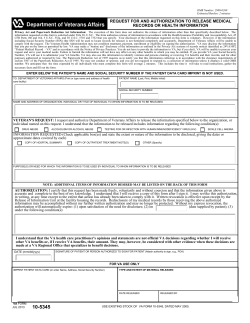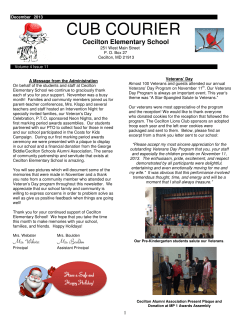
Diagnostic and Statistical Manual, 5 edition, – Diagnostic and Clinical Issues
Diagnostic and Statistical Manual, 5th edition, (DSM-5) Update for VA Mental Health Providers – Diagnostic and Clinical Issues Mehul Mankad, MD Staff Psychiatrist Durham VA Medical Center Clinical Associate Duke University Medical Center VETERANS HEALTH ADMINISTRATION Monday, September 9, 13 Disclosures • None VETERANS HEALTH ADMINISTRATION Monday, September 9, 13 2 Specific Aims • To understand the changes in framework from DSM-IV to DSM-5 • To appreciate specific changes in diagnostic criteria for commonly occurring disorders in the Veteran population • To review the new cross-cutting symptom measures and disease severity measures found in DSM-5 VETERANS HEALTH ADMINISTRATION Monday, September 9, 13 3 Criticisms of DSM-IV • High rates of comorbidity • High use of “Not Otherwise Specified” (NOS) category • Lack of laboratory markers • DSM-IV criteria are a decade old. Neuroscience has moved very quickly in that time span. • Criteria lack validity/not based in etiology • American document VETERANS HEALTH ADMINISTRATION Monday, September 9, 13 4 DSM-5 Development • • • • • 2006-2007 DSM-5 Task Forces 2007-2013 DSM-5 Workgroups Cross-cutting study groups >50% of participants from outside US 13 conferences, 10 monographs, and >200 journal articles published prior to release of DSM-5 VETERANS HEALTH ADMINISTRATION Monday, September 9, 13 5 Three Sections of DSM-5 Section I: Preamble, definitions, cautionary statements • Section II: 20 Mental disorder chapters • Section III: Items requiring further research – Emerging diagnoses – Dimensional model of personality disorders – Emerging measures • Cross-cutting • Symptom severity • Appendix • VETERANS HEALTH ADMINISTRATION Monday, September 9, 13 6 Changes in Framework I • Abandon Roman numerals! – DSM, DSM-II, DSM-III, DSM-IV… and now DSM-5 • Fewer total disorders (15 new, 2 discarded, and 28 combined) • Not Otherwise Specified now called Unspecified or Other Specified VETERANS HEALTH ADMINISTRATION Monday, September 9, 13 7 Changes in Framework II • Transition to International Classification of Diseases, 10th Edition (ICD-10), embedded in text • Differences with online version – References/bibliography available online – All severity measures available online VETERANS HEALTH ADMINISTRATION Monday, September 9, 13 8 Loss of the Multi-axial System • Discard the multi-axial system – Axes I, II, and III: All psychiatric and medical diagnoses given equal status; personality disorders remain intact (more or less) – Axis IV: now coded as V codes (ICD-9) and Z/T codes (ICD-10) – Axis V: replaced by World Health Organization Disability Assessment Schedule (WHODAS) 2.0 VETERANS HEALTH ADMINISTRATION Monday, September 9, 13 9 Highlights of Specific Diagnoses Neurodevelopmental Disorders – Attention-Deficit/ Hyperactivity Disorder (ADHD) • Schizophrenia Spectrum – Schizophrenia, Schizoaffective Disorder, Catatonia • Bipolar and Related Disorders – Bipolar disorder • Depressive Disorders – Major Depressive VETERANS HEALTH ADMINISTRATION Disorder • Monday, September 9, 13 • • • • • Anxiety Disorders (4 chapters) – Panic attacks, Hoarding Disorder, Posttraumatic Stress Disorder (PTSD) Sleep-Wake Disorders – Insomnia, REM Behavior Disorder (RBD), Restless Legs Syndrome (RLS), Sleep Apneas Substance Use Disorders Neurocognitive Disorders – Traumatic subtype, Alzheimer’s subtype Personality Disorders 10 ADHD • The number of symptoms required to make the diagnosis was reduced to five from six – Studies show that adults manifest fewer ADHD symptoms than children – This change should not lead to a significant change in prevalence of the adult ADHD diagnosis VETERANS HEALTH ADMINISTRATION Monday, September 9, 13 11 Schizophrenia • Elimination of Schneider’s first rank symptoms – No longer prioritizes special hallucinations and special delusions • Positive symptoms must be present to make diagnosis • Removal of schizophrenia subtypes VETERANS HEALTH ADMINISTRATION Monday, September 9, 13 12 Schizoaffective Disorder • Criteria now based on lifetime of co-occurring mood symptoms and psychotic symptoms in patients with mood-free residual psychosis • No longer cross-sectional, no longer emphasizes the current episode of co-occurring symptoms • Should lead to fewer patients receiving this diagnosis VETERANS HEALTH ADMINISTRATION Monday, September 9, 13 13 Catatonia • Now a specifier for many different mental disorders including mood, psychotic, and others • Can also be diagnosed as Catatonia Due to Another Medical Condition VETERANS HEALTH ADMINISTRATION Monday, September 9, 13 14 Bipolar Disorder • Increased energy now a diagnostic criterion choice (was conspicuously absent before) • “Mixed features” better captures subthreshold mixed states than the previous “Mixed episode” diagnosis – No longer requires full criteria of a major depressive episode and a concurrent manic episode VETERANS HEALTH ADMINISTRATION Monday, September 9, 13 15 Major Depressive Disorder • Bereavement exclusion dropped – Some healthcare systems were too literal in adhering to the old 8 week exclusion • Clear major depressive episodes (MDE) during periods of grief were not treated until the 9th week • Conversely, grief was being mislabeled as MDE if it persisted into the 9th week • “With anxious distress” is now a modifier for unipolar and bipolar disorders VETERANS HEALTH ADMINISTRATION Monday, September 9, 13 16 Anxiety Disorders • Research in the past decade supports the separation of the DSM-IV Anxiety Disorders chapter into four distinct chapters in DSM-5 – Anxiety disorders that are fear-based (i.e., phobias) – Obsessive Compulsive Disorder (OCD) and related disorders – Trauma-related anxiety disorders – Dissociative disorders VETERANS HEALTH ADMINISTRATION Monday, September 9, 13 17 Panic attacks specifier • Growing evidence supports the idea that panic attacks can occur in a variety of mental disorders (anxiety, mood, psychotic) without meeting criteria for full Panic Disorder VETERANS HEALTH ADMINISTRATION Monday, September 9, 13 18 Hoarding Disorder • Clinically significant hoarding behavior is now recognized as a distinct entity from OCD VETERANS HEALTH ADMINISTRATION Monday, September 9, 13 19 Posttraumatic Stress Disorder I • Criterion A (the stressor criterion) is more precise – Exclusion of nonviolent death of a loved one – Elimination of subjective experience of helplessness or horror • Military and first responders (i.e., police and fire fighters) rarely endorsed this criterion VETERANS HEALTH ADMINISTRATION Monday, September 9, 13 20 Posttraumatic Stress Disorder II DSM-IV Three Symptom Clusters Symptom Clusters • Criterion B: Reexperiencing • Criterion C: Avoidance/ numbing • Criterion D: Increased Arousal VETERANS HEALTH ADMINISTRATION Monday, September 9, 13 DSM-5 Four • Criterion B: Reexperiencing • Criterion C: Avoidance • Criterion D: Negative alterations in thoughts and mood • Criterion E: Increased arousal 21 Posttraumatic Stress Disorder III • New Criterion D: “Negative alterations in thoughts and mood” (2 required) – Inability to recall key aspects of the trauma – Persistent negative beliefs about the oneself or the world – Persistent distorted blame of self or others in causing the trauma – Diminished interest/anhedonia – Feeling alienated or detached from others – Constricted affect VETERANS HEALTH ADMINISTRATION Monday, September 9, 13 22 Sleep-wake Disorders • Primary Insomnia renamed Insomnia Disorder • Rapid Eye Movement Sleep Behavior Disorder and Restless Legs Syndrome now moved to Section II • Specific diagnostic criteria now found in DSM-5 for a variety of sleep apneas (obstructive, central, etc.) VETERANS HEALTH ADMINISTRATION Monday, September 9, 13 23 Substance Use Disorders I • Substance Abuse and Substance Dependence now combined into Substance Use Disorder (SUD) – Mild (2-3/11) – Moderate (4-5/11) – Severe (6+/11) VETERANS HEALTH ADMINISTRATION Monday, September 9, 13 24 Substance Use Disorders II • Removal of legal criteria – Legality of specific substances in different jurisdictions should not indicate presence or absence of a mental or medical disorder • Addition of craving criteria – Based on growing addictions research VETERANS HEALTH ADMINISTRATION Monday, September 9, 13 25 Neurocognitive Disorders • Replaces the term Dementia – Broadens the range of etiologies beyond diagnoses commonly seen in the elderly • Ten subtypes – Includes Traumatic Brain Injury – Includes Human Immunodeficiency Virus (HIV) • Can be Major or Mild VETERANS HEALTH ADMINISTRATION Monday, September 9, 13 26 Personality Disorders I • The ten classic personality disorders remain unchanged in Section II • These diagnoses can continue to be used in the absence of an Axis II section VETERANS HEALTH ADMINISTRATION Monday, September 9, 13 27 Personality Disorders II • A new dimensional model is available in Section III – Six personality subtypes • Antisocial, Avoidant, Borderline, Narcissistic, Obsessive Compulsive, Schizotypal, Personality Disorder-Trait Specified (PD-TS) – Five trait domains • Negative affectivity, detachment, antagonism, disinhibition, psychoticism • 25 trait facets within the five trait domains VETERANS HEALTH ADMINISTRATION Monday, September 9, 13 28 Optional Measures • Assess and track severity of symptoms – Cross-cutting measures: Self-administered • Level 1 – Screening tool – Relevant to most mental disorders – 13 symptom domains • Level 2 – More detailed analysis of positive Level 1 domain – Based on pre-existing scales – Diagnosis-specific measures: Self and ClinicianVETERANS HEALTH ADMINISTRATION rated Monday, September 9, 13 29 WHODAS • World Health Organization Disability Assessment Scale, Version 2.0 – Self-administered scales covering several domains of function – Not only related to mental disorder disability • Includes understanding and communicating, getting around, self care, getting along with people, household activities, work or school activities, participation in society VETERANS HEALTH ADMINISTRATION Monday, September 9, 13 30 Availability of Scales • All scales available for free download at: – www.psychiatry.org/dsm5 • Scales can also be found in the electronic version of DSM-5 • Limited scales are reproduced in the print version of DSM-5 VETERANS HEALTH ADMINISTRATION Monday, September 9, 13 31 DSM-5, ICD-9, and ICD-10 • DSM-5 is compliant with both ICD-9 and ICD-10 – Diagnoses have a six digit code listed next to them which corresponds with ICD-9 – Diagnoses have an alphanumeric code listed in parentheses which corresponds to ICD-10 – Some codes (particularly in ICD-9) have to be used for more than one disorder due to limited number of available entries VETERANS HEALTH ADMINISTRATION Monday, September 9, 13 32 DSM-5 Update for VA Mental Health Providers – Implementation Issues Marsden McGuire, MD Deputy Chief Consultant for Mental Health Standards of Care Mental Health Services Washington, D.C. VETERANS HEALTH ADMINISTRATION Monday, September 9, 13 33 Disclosures • None VETERANS HEALTH ADMINISTRATION Monday, September 9, 13 34 Coding of Diagnosis on Encounter Forms • VA uses ICD coding terminology for all outpatient diagnosis • Centers for Medicare and Medicaid Services (CMS) requirement to convert from ICD-9 to ICD-10 effective 10/1/2014—applies to all US healthcare systems covered under the Health Insurance Portability and Accountability Act (HIPAA) • VA encounter forms use currently ICD-9 diagnosis (not DSM) • Encounter forms will continue to use ICD-9 codes and terminology until conversion to ICD-10 in October VETERANS HEALTH2014. ADMINISTRATION Monday, September 9, 13 35 Implications in Implementing DSM-5 and ICD-10 • Clinical Guidance is to use DSM-5 effective approximately 10/1/13 – What does this mean for provider? – Encounter forms will still be based on ICD-9 terminology (which is equivalent of DSM-IV) – What constitutes “implement”? • Diagnostic criteria • Clinical decision making • But NOT a change in coding—DSM is for clinical decision making, ICD is the accepted coding terminology for all HIPAA covered healthcare organizations • Document that DSM-5 criteria are being used through 1st Quarter, FY14 VETERANS HEALTH ADMINISTRATION Monday, September 9, 13 36 Encounter Forms • Linked to clinic • Based on national encounter forms • Sites can use national form or customize their own — – Use of national forms preferred—customized forms have to be manually updated (such as new CPT codes) • Provides pick-list of diagnostic codes (based on ICD-9 coding terminology) • Can use Lexicon to search for “other diagnosis” – By code VETERANS HEALTH ADMINISTRATION – By Text Monday, September 9, 13 37 Sample Encounter Form You’ll continue to use the current DSM-IV codes and ICD-9 terminology. Encounter forms will not use DSM-5 codes or terms. VETERANS HEALTH ADMINISTRATION Monday, September 9, 13 38 Global Assessment of Functioning (GAF) • GAF is no longer part of the comprehensive diagnosis in DSM-5 • DSM-5 has moved to a nonaxial documentation of diagnosis • Dropped for several reasons – Lack of conceptual clarity – Questionable psychometrics in routine practice – Separate concepts of mental disorder and disability VETERANS HEALTH ADMINISTRATION Monday, September 9, 13 39 WHODAS • World Health Organization Disability Assessment Schedule 2.0 – Recommended by APA for disability/functional assessment – Not required by VHA VETERANS HEALTH ADMINISTRATION Monday, September 9, 13 40 Computerized Patient Record System (CPRS)/Mental Health Assistant (MHA) Updates • Patch YS*5.01*108 will make several updates based on DSM-5: – Elimination of GAF entries—will maintain historic entries for record review, but will no longer prompt for GAF or provide entry of new GAF scores – WHODAS 2.0 new instrument in MHA – Current versions of PCL (PTSD Checklist) will be retired; new PCL-5 will be introduced – National clinical reminders updated to introduce new PCL-5 rd quarter FY14 •VETERANS Anticipate release to field 3 HEALTH ADMINISTRATION Monday, September 9, 13 41 Other Updates • Mental Health Suite v4.0 will remove GAF, change diagnosis prompt to be nonaxial • Catastrophic Disability Determination will remove GAF references (has to be published in Federal Register first) • More information when ICD-10 implementation nears. VETERANS HEALTH ADMINISTRATION Monday, September 9, 13 42 General Guidance on DSM-5 Changes • • • Diagnostic codes (former Axes I, II, III) should be listed together, followed by codes for contributing factors (current V codes, former Axis IV) GAF (former Axis V) is no longer a component of formal diagnosis and its use is discouraged (special cases: MHICM, PRRC) Use of Emerging Measures and Models (Section III) is not required but should be considered where appropriate – E.g. WHODAS 2.0, Cross-cutting Measures, Cultural Formulation Interview – In time, some measures may become required (or be discontinued) in certain settings/programs – Note, however, that Conditions for Future Study are not yet ready for clinical use VETERANS HEALTH ADMINISTRATION Monday, September 9, 13 43 Questions? Mehul.Mankad@va.gov Marsden.McGuire@va.gov VETERANS HEALTH ADMINISTRATION Monday, September 9, 13 44
© Copyright 2025









